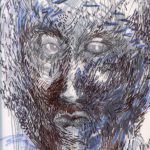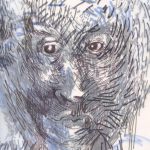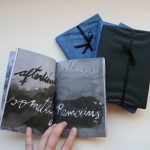- Title: The Black Book
- Author: Isabel Baraona
- Publisher: Isabel Baraona
- Dimensions: 17X12 cm (6,69X4,72 in)
- Number of Pages: 56 pages
- Edition: 250 copies
- Publishing Date: 2009 (March)
- Place: Cascais, Portugal
- Dep. Legal / ISBN: 290045/09 ; n.a.
- Media: Offset, colour, printset paper 120 gr. cover 300gr.
- Synopsis: The book begins and ends with a series of semi-opaque fragments of the image of one or more faces. The printed images are the result of several drawings on numerous layers of tracing paper, which were then superimposed on a de-matching (slightly displaced) way, and therefore fail to form a "complete" and recognizable face. We identify the drawing of a face by deciphering the markings and the places of eyes, nose and mouth - but it is neither a portrait, nor a self-portrait. It is a palimpsest-face: androgynous, without skin or organs, without bones or skull; the drawing suggests only features that change on the next page. It's the potential drawing of a face, and also its rapid and successive metamorphosis. Each of these drawings and their sequence could be the annotation of a cloud, swirling water or other vegetal or organic material that, for a second, would acquire the configuration of a face. The core of the story consists of a set of drawings that include narrative scenes and black pages with excerpts of sentences. The narrative scenes are characterized by dense groups of characters gathered around a game that, depending on the pages, is more or less violent, or sometimes watching a strange medical exam. In the black pages filled with liquid stains emerge incomplete sentences with inconclusive content such as “afterwards something remains”(originally written in English) and “stay here, always hesitate”. The sentence "afterwards something remains” doesn’t have a univocal sense; it implies that there is a “before” and an “after” (somehow marked on the body or in memory). Nor do we know which event has generated the fracture of time. But we know that it contains three possibilities: a continuity (it still is); or it produces something recent/new that is (that still is); or that this is something that already exists and is a leftover or surplus. The word "remains" can be read as a verb or a noun, acquiring two different meanings: "it still is” or "remnants". Despite these unknowns, we can easily relate this proposition with the repetition of drawings, in particular with the sequences that punctuate the beginning and end of the book (which we named "palimpsest-face"). In a strict formal sense, this book has no cover. In The Black Book the front cover opens the first series of drawings (which may be termed a first chapter), and the back cover closes the last series of drawings (or the last chapter). The Black book is sold-out. (Translation of the text provided by Isabel Baraona to Tipo.pt)
- Author's Website:http://www.isabelbaraona.com
- Publisher's Website:(Português) http://www.isabelbaraona.com
- Notes and Collections: This book is available at: - the Gulbenkian Foundation Library, Lisbon; at the School of Fine Arts and Design of Caldas da Rainha, Portugal. - Centre de la Gravure et de l’Image imprimée, La Louvière, Belgium; - Tate archives, in London, UK. - The School of Fine Arts at Minas Gerais (EBA/UFMG), Brazil.
Categories
The Black Book
Categories



